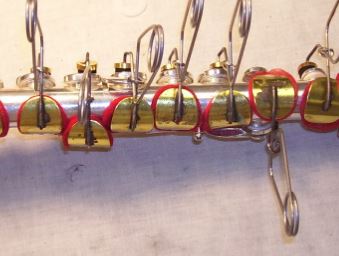-
Lohff & Pfeiffer
About Lohff & Pfeiffer
Iimprint
Contact
Newsletter
Location
L&P team
- Instruments
General
Trade options
About clarinet
Search specific instrument
Ab-clarinet
Eb-clarinet
D-clarinet
C-clarinet
Bb-clarinet
A-clarinet
Mozart basset-clarinet A
G-clarinet
Bassethorn F
Alto-clarinet Eb
Bass-clarinet
Contraalto Eb-clarinet
Contrabasse Bb-clarinet
German-Albert system Bb
Reform Boehm A & Bb
Peter Bastian Instruments
Plateau clarinets
Quartertone clarinet
- L&P Optimization
Optimization
Customization
Specialities
Special Keywork
- Accessories
General
Care products
For instruments
Reeds
Tools for reeds
Straps and hand rests
- Repair
Book time
About Repair
Maintenance
Plating-Surface treatment
Pads
Padding style
Cracks
Tone hole problems
Joints
- Tips & Advice
How to..
Videos
Worldwide external information
Problems & help
Education & learning

.Press-padding or Steaming
The technique
The pads will be installed inside the pad cups and the keys will be mounted onto the instrument. Afterward, the entire instrument will be exposed to high humidity and heat, typically in an oven, with a heat-gun or in a sauna-like room with all keys pressed down onto the instrument. The pad will remold itself to the shape of the tone hole.
The result
This method will leave a big impression on the pad. A large surface will touch the tone hole, at first giving the impression of a good seal. The tone hole shaped impression will touch the body on a large surface. Dirt and humidity getting on the pad will prevent the pad from properly closing. An irritating sticky noise is often noticeable. The seal doesn't last very long and the fish skin gets stretched, which also reduces the life expectancy of the pad. The result is mediocre and often even worse. Press padding is typically done in mass production at cost-concerned workshops. It is usually applied to fish skin, bladder, or synthetic pads.
The consequences
The player, unaware of the bad quality, will believe that the lack of performance is his fault. He will need to press harder but still will not get a full sound. His technique will not get a good start and he will have to develop a lot of bad habits to get it to work.
The conclusion
The "cheap" instrument or repair turns out to be very expensive in the long run, due to the development of bad habits and lots of lost time.
Help us to get better
Was this article helpful?
Comments, additions or questions are always welcome at: info@clarinet.dk(C) 2014 - by Lohff & Pfeiffer - Brøndbyvej 211 - 2625 Vallensbæk + 45 3535 8643 - SE DK 1895 7485 info@clarinet.dk - Instruments






